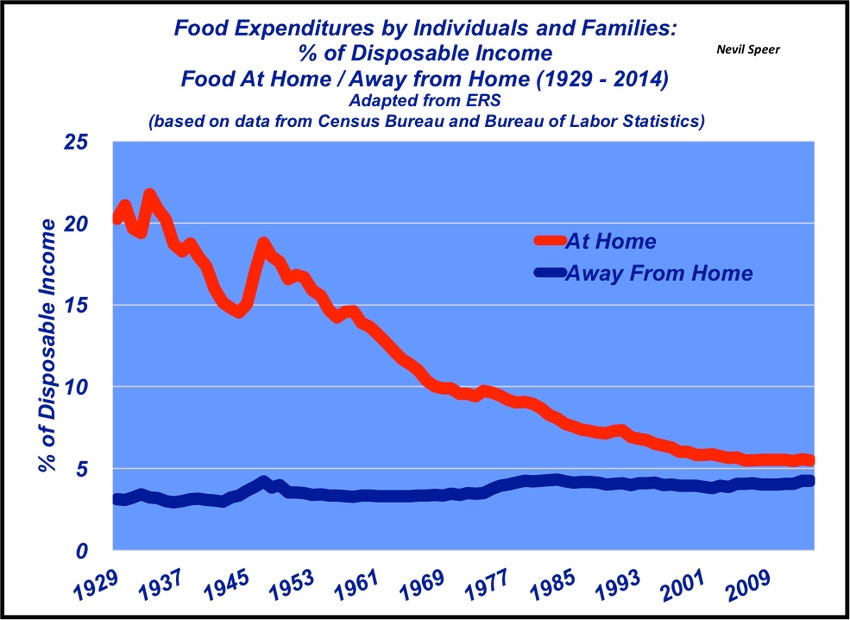As America became more prosperous in the post-war era, food spending dropped as a percent of disposable income.
September 15, 2016

The past several columns have indirectly focused on the general state of the economy and the subsequent influence on the beef industry.
The first column addressed the general trend in job creation since the financial crisis. The column noted that, “…one of the key indicators for consideration [around monetary policy] stems from the Bureau of Labor Statistics. The agency’s Jobs report, formally known as the Employment Situation Summary, is highly anticipated every month by traders as proxy for economic growth. The August report marked 255,000 new jobs being created in July – well ahead of pre-report expectations.
The second column highlighted a newly released report from the Congressional Budget Office (CBO) titled, Trends in Family Wealth, 1998 to 2013. The report focused on shifts in family wealth distribution over time.
Most notable within that report, CBO explains that, “The share of wealth held by families in the top 10% of the wealth distribution increased from 67% [in 1998] to 76% [in 2013], whereas the share of wealth held by families in the bottom half of the distribution declined from 3% to 1%.”

This week’s illustration strikes closer to home. It features food spending by individuals and families as a percentage of disposable income over time. Clearly, the change over time has had a tremendous impact on economic prosperity and general living standards for Americans in the past 50 to 100 years.
There are several key takeaways from the data. First, overall spending on food has declined dramatically in the post-war era. In fact, it reached an all-time low in 2008 at 9.5%. Most recently, total food spending equaled 9.7% of disposable income in 2014.
Second, that reduction is almost solely due to the downward shift in at-home spending. That’s freed up disposable income to do lots of other things—recreation, purchase bigger homes, etc. Third, practically speaking, the relative proportion of spending at-home versus away-from-home has remained relatively constant in recent years.
Therefore, the real struggle for food dollars in the U.S. is an attempt to shift that relative spending mix: total U.S. food expenditures equaled $1.26 trillion in 2014 – thus, even a small swing one way or the other results in large dollar amounts.
Many of us in agriculture and the food business know the importance of these trends. (And often lament that the general public doesn’t possess more appreciation for this reality.) Nevertheless, it’s always useful to remind ourselves how dramatic the change has been over time. How do you perceive the overall trends? What impact has this had on the beef industry? What changes do you foresee in the future with respect to consumers and their food spending habits? Leave your thoughts in the comments section below.
Nevil Speer is based in Bowling Green, Ky., and serves as vice president of U.S. operations for AgriClear, Inc. – a wholly-owned subsidiary of TMX Group Limited. The views and opinions of the author expressed herein do not necessarily state or reflect those of the TMX Group Limited and Natural Gas Exchange Inc.
You might also like:
Young ranchers, listen up: 8 tips from an old-timer on how to succeed in ranching
13 utility tractors that will boost efficiency in 2016
Burke Teichert: How to cull the right cow without keeping records
3 weaning methods compared; Which one rises to the top?
6 tips for proper electric fence grounding
9 things to include in your ag lease (that you better have in writing!)
About the Author(s)
You May Also Like





